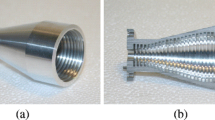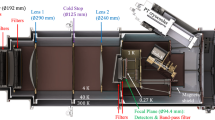Abstract
A novel receiver optical system designed for Korean VLBI Network (KVN) has been used for conducting simultaneous millimeter-wave very long baseline interferometry (VLBI) observations at frequencies of 22, 43, 86, and 129 GHz. This multi-frequency band receiver system has been effective in compensation of atmospheric phase fluctuation by unique phase referencing technique in mm-VLBI observations. However, because the original optics system incorporated individual cryogenic receivers in separate cryostats, a rather bulky optical bench of size about 2600 mm x 2300 mm x 60 mm was required. To circumvent difficulties in installation and beam alignment, an integrated quasi-optical circuit incorporating a more compact triple-band receiver in single cryostat is proposed in this paper. The recommended frequency bands of the improved triple-band receiver are K(18–26 GHz) band, Q(35–50 GHz) band, and W(85–115 GHz) band. A frequency-independent quasi-optical circuit for triple band is adopted to obtain constant aperture efficiency as a function of the observed frequencies. The simulation results show that total aperture efficiency of each recommended frequency band is maintained almost constant within 1%. We present the design details of the compact wideband quasi-optical circuit and the triple-band receiver optimized for simultaneous multi-frequency observations.









Similar content being viewed by others
References
Ryle, Hewish, The synthesis of large radio telescopes, Monthly Notices of the Royal Astronomical Society, Vol. 120, p.220 (1960).
Clark et al., Angular Size of 3c 273B, Astrophysical Journal, vol. 149, p.L151 (1967).
Moran et al., Spectral Line Interferometry with Independent Time Standards at Stations Separated by 845 Kilometers, Science, Volume 157, Issue 3789, pp. 676-677 (1967).
Lee et al., Early Science with the Korean VLBI Network: Evaluation of System Performance, The Astronomical Journal, Volume 147, Issue 4, pp. 77-90 (2014).
S. T. Han et al., Millimeter-wave Receiver Optics for Korean VLBI Network, Int. J. Infrared and Millimeter Waves, Vol. 29, No. 1, pp.69-78 (2008).
S. T. Han et al., Korean VLBI Network Receiver Optics for Simultaneous Multifrequency Observation : Evaluation, Publication of the Astronomical Society of the Pacific, Vol. 125, pp.539-547 (2013).
Asaki et al., Phase compensation experiments with the paired antennas method 2. Millimeterwave fringe correction using centimeter-wave reference, Radio Science, Vol. 5, pp.1297-1318 (1998).
M. J. Rioja et al., Verification of the Astrometric Performance of the Korean VLBI Network, Using Comparative SFPR Studies with the VLBA at 14/7 mm, The Astronomical Journal, Vol. 148, No. 5, pp.84-98 (2014).
T. Jung et al., First Simultaneous Dual-Frequency Phase Referencing VLBI Observation with VERA, Publications of the Astronomical Society of Japan, Vol. 63, No. 2, pp.375-385 (2011).
T. Jung et al., First simultaneous 4-frequency phase referencing test for mm-VLBI observation, Proceedings of EVN Symposium (2012).
M. J. Rioja et al., The Power of Simultaneous Multifrequency Observations for mm-VLBI: Astrometry up to 130 GHz with the KVN, The Astronomical Journal, Vol. 150, No. 6, pp.202-215 (2015).
J. W. Lamb, Quasioptical coupling of Gaussian beam systems to large Cassegrain antennas, Int. J. Infrared and Millimeter Waves, Vol. 7, No. 10, pp.1511-1536 (1986).
J. W. Lamb, Low-Noise, High-Efficiency Optics Design for ALMA Receivers, IEEE Trans. Antenna and Propagation, Vol. 31(8), pp.2035-2047 (2003).
General Radiator Analysis Software Package, www.ticra.com.
P. F. Goldsmith, Quasioptical systems : Gaussian Beam Quasioptical Propagation and Ap- plications, IEEE Press, New York (1998).
T. S. Chu, An Image Beam Waveguide Feed, IEEE Trans. Antenna and Propagation, Vol. AP-31, No. 4, pp.614-619 (1983).
KVN Radio telescope Optic Geometry, Antedo Technical Memo KVN-21M-TM-130, April (2005).
P. Zorzi et al., Construction and measurement of a 31.3-45 GHz optimized spline-profile horn with corrugation, Int. J. Infrared and Millimeter Waves, Vol. 33, pp.17-24 (2012).
P. Ade et al., A Review of Metal Mesh Filters, Proc. of Society of Photo-Optical Instrumentation Engineers, Vol. 6275, pp.1-15 (2006).
Jacob. Kooi, Private communication.
S. Withington et al, On the Design of Broadband Quasioptical System for Submillimeterwave Radio Astronomy Receivers, Int. J. Infrared and Millimeter Waves, Vol. 13, No. 10, pp.1515-1537 (1992).
J. A. Murphy, Distortion of a simple Gaussian beam on reflection from off-axis ellipsoidal mirrors, Int. J. Infrared and Millimeter Waves Vol. 9, No. 9, pp.1165-1187 (1987).
S.B. Sørensen, K. Pontoppidan, Analysis of the ALMA Telescope and Front-ends, Proceeding of 21st International Symposium on Space Terahertz Technology, pp.121-127 (2010).
Acknowledgements
This work was carried out in part at the Jet Propulsion Laboratory, which is operated for NASA by the California Institute of Technology.
Author information
Authors and Affiliations
Corresponding author
Rights and permissions
About this article
Cite this article
Han, ST., Lee, JW., Lee, B. et al. A Millimeter-Wave Quasi-Optical Circuit for Compact Triple-Band Receiving System. J Infrared Milli Terahz Waves 38, 1487–1501 (2017). https://doi.org/10.1007/s10762-017-0438-2
Received:
Accepted:
Published:
Issue Date:
DOI: https://doi.org/10.1007/s10762-017-0438-2




